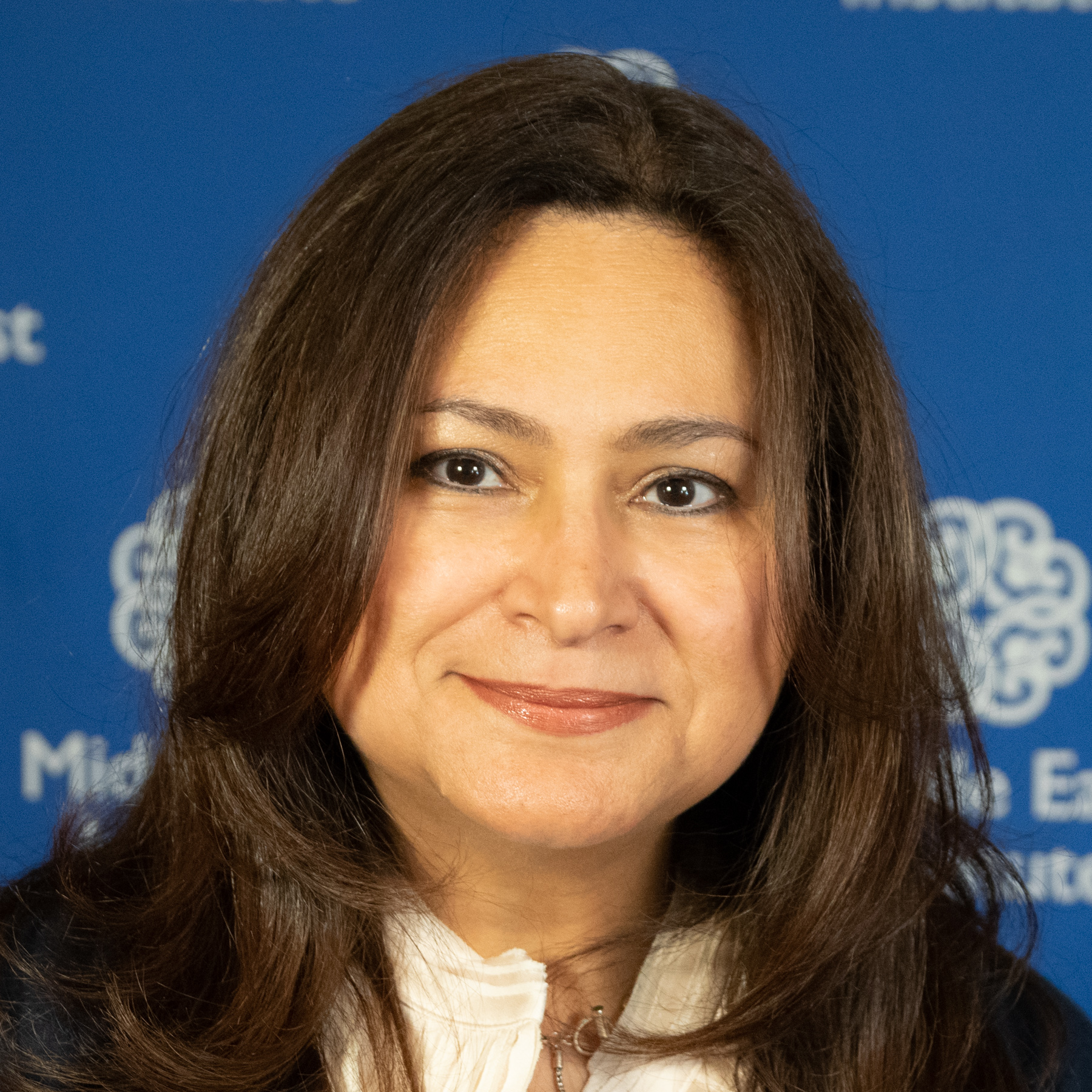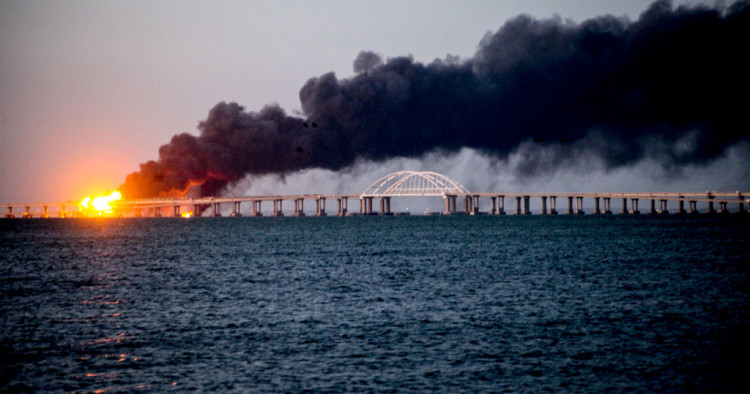Contents:
- Ukraine’s ‘sick burn’ to Putin’s pet project
- For Saudi Arabia, the OPEC+ decision is a declaration of independence
- "Disinformation bill" takes Erdoğan’s digital crackdown to a new level
- US forces conduct counterterrorism raid in Assad-controlled territory
- Egypt scrambles to shore up its economy
- The limited thawing of US-Pakistani relations
Ukraine’s ‘sick burn’ to Putin’s pet project
Robert E. Hamilton
Non-Resident Scholar

-
On Saturday, a powerful truck bomb exploded on the Kerch Strait Bridge, which links occupied Crimea and mainland Russia, dropping sections of two lanes of the road span into the sea and damaging the rail span.
-
In practical terms, the damage to the bridge will further hamper Russia’s efforts to logistically support its military campaign in southern Ukraine, for which Crimea is an important staging base.
On Saturday, a massive explosion rocked the Kerch Strait Bridge, the only land link from Russia to Crimea, which Russia illegally annexed in 2014. Opened in 2018, the 19-kilometer (11.85 miles) bridge consists of a road span with four traffic lanes and a rail span with two tracks. A truck bomb reportedly caused the blast, which dropped sections of two lanes of the road span into the sea and damaged the rail span. Russian authorities emplaced barriers to wall off the damaged area on one of the undamaged lanes, leaving only one lane open to traffic.
The attack on the bridge has both symbolic and practical implications. It occurred a day after President Vladimir Putin’s 70th birthday, and the bridge holds special meaning for the Russian leader. Putin personally inaugurated the bridge in 2018, driving a truck across it and proclaiming that as far back as the days of the czars, “people dreamed of building this bridge.” While Ukraine has not yet directly claimed responsibility for the attack, Ukrainian government figures have celebrated it. Mykhailo Podolyak, an advisor to Ukrainian President Volodymyr Zelenskyy, said the bridge was only “the beginning” and that “everything illegal must be destroyed.” The Twitter account of the Ukrainian government was more succinct, tweeting “sick burn.”
In practical terms, the damage to the bridge will further hamper Russia’s efforts to logistically support its military campaign in southern Ukraine, for which Crimea is an important staging base. Holding and militarily strengthening the territories adjacent to Crimea, including occupied Kherson and neighboring Mykolaiv, would also be crucial for any attempted Russian ground assault on Ukraine’s critically important Black Sea ports. Russian authorities have reopened the one remaining traffic lane to cars but have said that trucks and other heavy vehicles — meaning all military logistical vehicles — must cross the strait by ferry. Russia claims the rail bridge – also critical to its military logistics effort in Ukraine – is open again, but given the severe damage it suffered in the explosion, there are doubts about it stability and capacity. Engineering experts say repairs to the bridge will take several months, at a time when Russian forces in southern Ukraine are facing increasingly successful Ukrainian counterattacks.
Russia’s response to the attack came swiftly. On Monday morning, the Russian military launched some 81 cruise missiles at Ukrainian cities, including Kyiv, Lviv, Ternopil, Zaporizhzhia, and Dnipro, killing dozens of civilians. More ominously, given that Russian doctrine allows use of nuclear weapons in response to attacks on “critical infrastructure,” television host Vladimir Solovyov urged the Kremlin to respond “by all means available.” Finally, only hours after the attack, Russia announced that Gen. Sergei Surovikin would take charge of the campaign in Ukraine. Surovikin’s checkered history includes leveling Syrian cities during his time leading Russian forces there, auguring more indiscriminate attacks like those Russia launched on Monday.
For Saudi Arabia, the OPEC+ decision is a declaration of independence
Gerald M. Feierstein
Distinguished Sr. Fellow on U.S. Diplomacy; Director, Arabian Peninsula Affairs

-
What the OPEC+ decision makes clear is that the effect of Saudi decision-making on U.S. national interests will be, at the most, one factor among many for the Saudi leadership and will not be determinative.
-
The decision probably will not have a substantial short-term impact on ties, but it likely cements in place the transactional nature of the bilateral relationship.
After a campaign season spent excoriating Saudi Arabia and its de facto ruler, Crown Prince Mohammed bin Salman, Joe Biden made the difficult decision this summer that he would need to visit the kingdom with a proposal to open a new chapter in the perennially challenged bilateral relationship. What he suggested in Jeddah was to move relations to a new strategic plane. Defense and security and a stable energy market were still pillars of the relationship, and the president made clear that the U.S. commitment to regional security was unchanged. But he was also clear that he did not come to talk about oil. Instead, as the joint communique issued at the conclusion of the summit meeting reflected, Biden saw the visit as an opportunity to engage the Saudis and their Gulf Cooperation Council (GCC) partners on a cooperative agenda to address a broad array of issues, including global economic recovery efforts, climate change, food security, and global health.
The reality of Saudi leadership as the driving force in the OPEC+ decision to cut the consortium’s output by two million barrels a day makes clear that the Saudis were unmoved by the Biden initiative and uninterested in turning the page on bilateral relations. Indeed, a number of U.S. observers have cast the Saudi position at the Vienna meeting as a purposeful slap at the Biden administration, an allegation vigorously denied by those speaking on behalf of Riyadh. In fact, given the softness in the global energy market, the rising prospect of a worldwide recession, and the reality that actual OPEC production was already well below the posted daily output, the real impact of the decision on prices at the gas pump is difficult to assess.
What the decision does make clear, however, is that the effect of Saudi decision-making on U.S. national interests will be, at most, one factor among many that the Saudi leadership will consider before drawing their conclusions and will not be determinative. Furthermore, the fact that the production cut might facilitate Russian aggression in Ukraine appears not to have been a factor at all or might even have been a positive factor as a gesture to Russian President Vladimir Putin.
Cooperation on issues of mutual importance still serves the interests of Washington and Riyadh. Thus, it’s unlikely that the OPEC+ decision will have a substantial short-term impact on the bilateral relationship. Nevertheless, the decision likely cements in place the transactional nature of the relationship. Most importantly, it frees the Biden administration, which was uncomfortable with the Saudi ties in any event, to pursue more aggressively U.S. initiatives, including, in the short term, maximizing domestic oil and gas production and doubling down, over the longer term, on the move away from fossil fuels and toward renewables and conservation.
MEI will be publishing a Special Briefing on the announced OPEC+ production cut and its broader implications on Thursday, Oct. 13.
“Disinformation bill” takes Erdoğan’s digital crackdown to a new level
Gönül Tol
Director of Turkey Program and Senior Fellow, Frontier Europe Initiative

-
Journalists, rights watchdogs, and opposition parties view the “disinformation bill” as Erdoğan’s latest attempt to silence critics ahead of next year’s elections.
-
The bill would introduce prison sentences of between one to three years for “spreading misleading information” on national security, public order, and health.
Turkish President Recep Tayyip Erdoğan is pressing ahead with a new law that he says is necessary to tackle the “serious threat” from disinformation in the press and social media. Journalists, rights watchdogs, and opposition parties, however, view the “disinformation bill” as Erdoğan’s latest attempt to silence critics ahead of next year’s elections. The legislation was first suggested by Erdoğan last year after he and his government faced criticism on social media over its poor response to the country’s worst-ever wildfire season. Social media users mocked Erdoğan, who traveled to the worst-hit areas and tossed packages of tea to residents, as “AKParTea,” a play on the ruling Justice and Development Party’s (AKP) initials, trended on Twitter. Even the government’s promise to rebuild houses destroyed by fire drew widespread criticism on social media after an AKP official, who announced that those who lost homes would enjoy low-interest-rate loans, told a reporter, “I think people with very old houses will say, ‘If only our homes had burnt too.’”
The criticisms Erdoğan faced on social media after last year’s wildfires intensified the president’s efforts to silence his critics in the press and online. The crackdown had already taken a worrying turn in the aftermath of the coup attempt in 2016, when more than 100 online and offline media outlets were forced to shut down. Following the country’s transition from a parliamentary to presidential system in 2018, Erdoğan muzzled dissent on social media further. The Turkish Radio and Television High Council now has the power to regulate platforms like Netflix, while under the 2020 social media law the government has extended its control over platforms such as YouTube, Facebook, and Twitter.
The latest bill will be used by Erdoğan to stifle dissent to an even greater extent. The 40 draft articles include the introduction of prison sentences of between one to three years for “spreading misleading information” on national security, public order, and health. But the provisions are vaguely worded, giving the already highly politicized judiciary even more room to silence critical voices. Thanks to the parliamentary majority the AKP and its far-right ally the Nationalist Action Party enjoy, 14 of the bill’s 40 articles have already been adopted. When the bill is signed into law, Erdoğan will have taken the digital crackdown to a whole new level ahead of the critical elections in 2023.
Follow on Twitter: @gonultol
US forces conduct counterterrorism raid in Assad-controlled territory
Charles Lister
Senior Fellow, Director of Syria and Countering Terrorism & Extremism programs

-
The U.S. military’s high-profile operations in northern Syria underline that the threat posed by ISIS remains ever present and that the U.S. troop presence in northeastern Syria remains vital to collecting intelligence and countering the terrorist group in an increasingly complex environment.
-
ISIS attacks in Syria have increased in frequency, scale, and impact for two-and-a-half months, consecutively, particularly in areas controlled by U.S. partners, the SDF.
For the first time in 14 years, the United States military launched a counterterrorism raid inside territory controlled by Syria’s regime late on Oct. 5 — killing a senior ISIS weapons smuggler and facilitator. The helicopter-borne operation targeted and eliminated a veteran ISIS operative, Rakkan Wahid al-Shammari, who for at least two years had been operating within regime areas south of the city of Qamishli. Two members of the regime’s National Defense Force (NDF) were discovered within Shammari’s safehouse, detained during the raid, and taken away by U.S. troops. Just hours later, on Oct. 6, a precision U.S. airstrike killed ISIS’s deputy leader for Syria, Abu Hashum al-Amawi (Abu Ala’a) and another ISIS commander, Abu Muwad al-Qahtani, in an undisclosed location in northern Syria.
That two such high-profile operations were launched against ISIS within hours of each other in northern Syria underlines both that the threat posed by that terrorist group remains ever present and that the U.S. troop presence in northeastern Syria remains vital to collecting intelligence and countering ISIS. Attacks by ISIS have now increased in frequency, scale, and, impact for two-and-a-half months, consecutively, particularly in areas controlled by U.S. partners, the Syrian Democratic Forces (SDF). In late September, two separate large-scale ISIS attacks, involving three suicide vehicle bombs and multiple additional suicide bombers, were intercepted, and the biggest ISIS arms cache seizure in several years was discovered by the SDF. Through August and September, a weeks-long SDF operation inside the al-Hol camp led to the arrest of 300 alleged ISIS operatives and the seizure of dozens of weapons, grenades, and sizeable quantities of explosives.
Whereas a majority of ISIS attacks targeted areas controlled by Syria’s regime in 2020 and 2021, the terrorist group appears to have refocused its attention in 2022 on the SDF-held northeast. A particular emphasis is being placed by ISIS on the need to free male detainees (of which there is a total of at least 11,000) from a network of roughly 20 makeshift ISIS prisons and the 56,000 women and children currently held in the al-Hol and al-Roj internment camps. As history has made clear, ISIS and its predecessors in Iraq have utilized imprisoned personnel to significant mobilizing effect in the past, so this period of increased ISIS activity requires a determined counter-response.
Recent U.S. and SDF successes are an encouraging start, but questions should rightly be raised about why a critically important ISIS figure was operating not just inside regime-held territory but seemingly alongside pro-regime NDF personnel. Syria’s regime has an extensive and well-documented track record of covert cooperation and indirect facilitation of ISIS, both in Iraq and inside Syria itself. Were that to be re-emerging, amid increasing Iranian-sponsored attacks on U.S. troops in Syria, then the counter-ISIS campaign may be entering a period of unprecedented complexity.
Follow on Twitter: @Charles_Lister
Egypt scrambles to shore up its economy
Mirette F. Mabrouk
Senior Fellow and Founding Director of the Egypt program

-
Depending on what one is reading, and where they’re reading it, the Egyptian economy is either rapidly collapsing or making slow but steady progress back from the precipice
-
Egypt faces an acute foreign currency shortage, resulting in vital grain supplies, like wheat, and corn and soy for poultry feed, being held up at ports.
It is fair to assume that casual observers of the Egyptian economy may be a little confused at the moment.
Depending on what one is reading, and where they’re reading it, the economy is either rapidly swirling down the drain or making slow but steady progress back from the precipice.
The latter view is supported by some solid figures. For example, Egypt’s net foreign direct investment inflows came in at $8.9 billion this past fiscal year (2021-2022), up 71.4% from the previous fiscal period, the bulk of which comprised investments in the non-oil sector.
Also, the current account deficit contracted by 10.2%, to $16.6 billion, from $18.4 billion the previous fiscal year. The Central Bank of Egypt (CBE) attributes this largely to a few factors: the rise in oil and non-oil merchandise, up a whopping 53.1%, a doubling of tourism-sector revenues, and higher revenues from the Suez Canal.
However, it’s also true that Egypt’s overall balance of payments posted a deficit of $10.5 billion, mostly due to capital flight, when foreign investors in Egypt’s portfolio reacted to the Russo-Ukrainian war the way foreign capital always reacts to global uncertainty — it promptly fled to developed economies. Almost half of the losses were in the first six months of this year.
In September, Egypt’s Central Agency for Public Mobilization and Statistics announced that annual headline inflation hit 15.3%, a four-year high and up 8% from last year. The country is also facing an acute foreign currency shortage, resulting in vital grain supplies, like wheat, and agricultural production inputs, such as corn and soy for poultry feed, being held up at Egyptian ports. The Chamber of Cereals Industry and the Union of Poultry Producers have both appealed to the CBE to release more liquidity.
Meanwhile, banks have stepped in with restrictions on debit card use abroad to prevent dollars being siphoned out of Egypt, at a time when the Egyptian pound has reached a record low of 19.7 against the U.S. dollar. According to Bloomberg Asharq, some banks capped use at a mere $500 a day while others have raised their transaction costs from 3% to 6%. The measures are likely to have been enacted under advice from the CBE.
Many of Egypt’s current economic difficulties are exacerbated by the various concurrent global economic crises, including continued fallout from the COVID-19 pandemic and the disastrous effects of the Russian war on Ukraine. However, there is no denying that these crises placed strain on already existing cracks that would have needed maintenance regardless, in the form of critical structural corrections. As Egypt awaits an imminent International Monetary Fund loan, which would signal confidence in its economy, it remains to be seen whether it will be able to step up and make those long-delayed necessary reforms.
Follow on Twitter: @mmabrouk
The limited thawing of US-Pakistani relations
Marvin G. Weinbaum
Director, Afghanistan and Pakistan Studies

-
While there is evident warming of bilateral U.S.-Pakistani relations, the most tangible change to date seems to be the renewal of a dormant defense partnership.
-
Real limits exist to the scope and depth of the U.S.-Pakistani engagement due to diverging strategic interests in the region, competing crises, and suspicions inside Pakistan.
Efforts to repair and reset the United States and Pakistan’s relationship appear well underway. They have been highlighted by the recent visits to Washington of Pakistan’s army chief and its foreign minister, the revival of U.S. funding for Pakistan’s military, timely humanitarian aid, and American-backed financial assistance to Pakistan’s struggling economy. What has been a relationship narrowly focused on counterterrorism is broadening. Much of this would have been impossible without a government change in Islamabad this past April.
In this, the 75th anniversary of the U.S.-Pakistani relationship, Gen. Qamar Javed Bajwa received a warm welcome at the Pentagon and in other high-level meetings in Washington last week. So too did Foreign Minister Bilawal Bhutto Zardari the week before. These visits came soon after the U.S. announced the provision of $66 million in assistance to flood-ravaged Pakistan. In August, the IMF gave final approval for $1.1 billion in budget support, an action greenlighted by Washington. And in July, the U.S. sent an ambassador to Islamabad, a post that had remained unfilled for four years.
Gen. Bajwa’s designated “farewell tour” — he is scheduled to retire next month — stressed Pakistan’s shared security objectives with the U.S. The visit followed on the Biden administration’s urging Congress to approve $450 million for the maintenance of Pakistan’s fleet of F-16 fighter aircraft and an announced potential sale of additional planes. U.S. Secretary of State Antony Blinken described the policy shift as needed to bolster Pakistan’s capacity to deal with terrorist threats. The improved substance and tone of U.S.-Pakistani relations stand in sharp contrast to those just six months ago, when then-Prime Minister Imran Khan, in the throes of being ousted from office, accused the U.S. of conspiring with his political opposition and trying to dictate Pakistan’s foreign policy.
Pressing the case for U.S. reengagement with Pakistan is a report released last week by a Pakistan Study Group made up of several former ambassadors and prominent Washington think tank analysts (including the author). The report argues that historically, whenever the U.S. has turned its back on Pakistan and the region, things have turned out badly and points to areas today where Pakistan and U.S. interests converge, including in seeking regional stability, combating terrorism, and averting armed conflict in South Asia. Although the report emphasizes security cooperation, especially on counterterrorism and nuclear safeguards, it also stresses the importance of U.S. funding for Pakistan’s economic and gender empowerment as well as food and energy security. Its authors clearly favor partnership with a politically stable and democratic Pakistan. Similar support for increased engagement came from another study group in a March 2020 report published by the Middle East Institute.
Real limits continue to exist to the scope and depth of U.S.-Pakistani engagement. The strategic interests of both countries often strongly diverge, particularly over Pakistan’s policies toward Afghanistan, China, and India. Moreover, with the U.S. gone from Afghanistan and other global issues occupying policymakers in Washington, Pakistan cannot expect to recapture the attention it once commanded from them. Attempts to strengthen ties also run into resentments and suspicions of the U.S. by most Pakistani elites and the wider public. Even an improving relationship is likely to remain largely transactional. While bilateral relations are evidently warming, the most tangible change to date seems to be the renewal of a dormant defense partnership.
Shizah Kashif, a research assistant to Marvin G. Weinbaum, assisted with the production of this article.
Follow on Twitter: @mgweinbaum
Photo by Vera Katkova/Anadolu Agency via Getty Images
The Middle East Institute (MEI) is an independent, non-partisan, non-for-profit, educational organization. It does not engage in advocacy and its scholars’ opinions are their own. MEI welcomes financial donations, but retains sole editorial control over its work and its publications reflect only the authors’ views. For a listing of MEI donors, please click here.













